Everything you need to know about the soft blind area
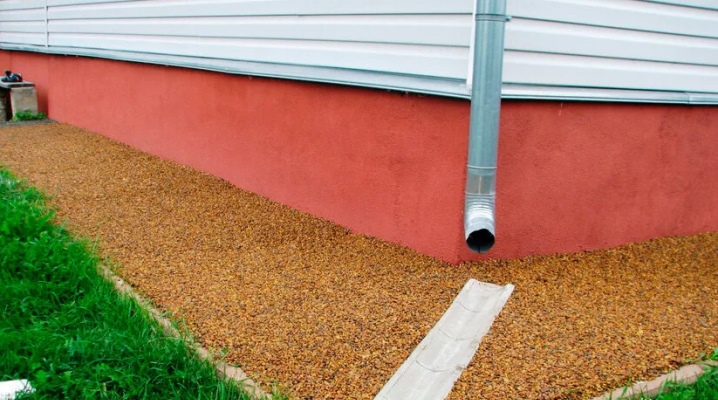
The soft blind area around the house and the well is well suited for arranging a summer cottage, allowing for effective removal of excess moisture. The device of the flexible tape is simplified as much as possible, does not require complex manipulations, while the structure copes with its tasks 100%. A detailed story about how to correctly make a hidden blind area with your own hands according to step-by-step instructions will allow you to understand all the important points of this process.
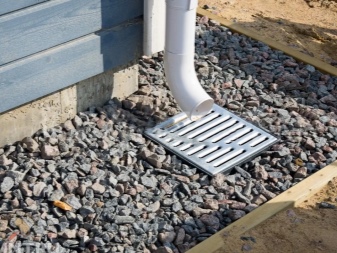

What it is?
A blind area is a structure that is erected around capital structures to drain excess moisture. For a long time it was believed that the concrete (rigid) version of the structure is better suited for these purposes. But over time, a soft blind area has gained popularity, allowing for a long time to solve the problem of drainage of water that falls out with precipitation or flows from the roof. Flexible tape distributes loads more evenly; it is mounted around the house for buildings on screw piles and for options with a solid monolithic foundation, and the hidden part of such a multi-layer "pie" is always noticeably thicker than the classic concrete one.
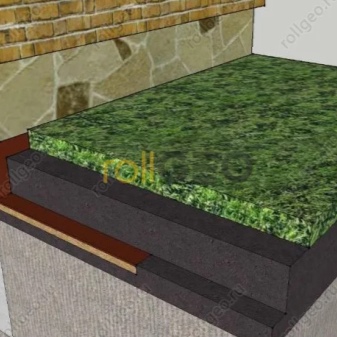
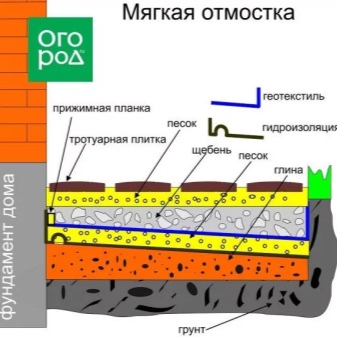
Installation of a soft blind area is possible not only in the local area. It can also be arranged around a well or a country cottage, a warm chicken coop or a utility block. Like other types of drainage structures, the soft blind area has its advantages and disadvantages. Let's start with its obvious advantages.
- Resistant to temperature extremes. When the soil freezes, the multilayer structure does not move.
- Stable geometric parameters. The flexible blind area does not shrink, therefore, it eliminates possible cracking of the base, supporting elements. It practically does not require repair and restoration throughout the entire service life.
- Compatible with membrane materials. Such a layer allows to improve the waterproofing performance of the structure, to increase its heat capacity.
- Simplicity of arrangement. The costs, both physical and material, in this case are not too high.
- Aesthetics. You can use various materials in the decoration, plant a lawn on top, break a flower bed.
There are also disadvantages. They are mainly associated with the fact that green spaces are placed on top of the soft blind area. It is important to make sure that their roots do not grow too much. In addition, in clayey soil, the layer of pebbles and crushed stone must be periodically cleaned of adhering soil particles. Otherwise, the throughput of the formed blind area will decrease.
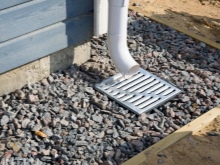
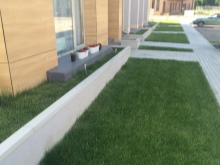
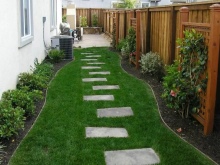
What materials are used?
The soft blind area is made of crushed stone or pebbles, the size of the fractions is selected based on the characteristics of the soil: without clay or with its high content. Also drainage includes sand, which provides quick moisture removal. The composition also includes a layer of waterproofing material: a polyethylene-based membrane, roofing felt, a PVC-based film coating.
Another must-have is geotextile. Its role in the composition of the soft blind area is very important. The material not only excludes silting, washing of crushed stone and sand in clay soils, but also provides opportunities for a more even distribution of loads. Depending on the type of soil, a thermally bonded or needle-punched variety is used.Woven fabrics for arranging a soft blind area are not recommended, since they do not provide a sufficient quality of waterproofing.
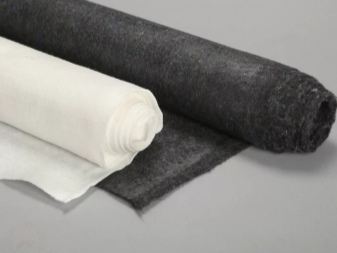
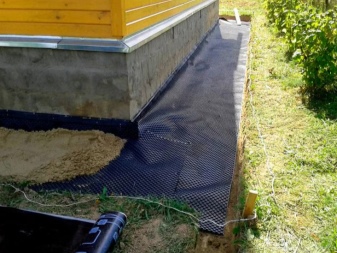
An additional component can be a heat-insulating layer. It is optional to use, but it significantly eases the problems associated with soil heaving during freezing. If the region is in a cold climatic zone, additional insulation around the foundation, the basement of the house, the well log will be a good protection.
Pure clay without impurities is another component of a flexible blind area. If it is dirty on the site, you will have to use imported dry material.

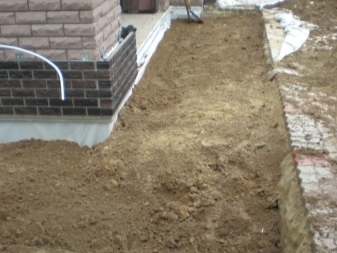
Required tools
When creating a soft blind area, a minimum amount of hand tools is used. When carrying out work, you will need the following inventory:
- protective gloves;
- shovels: shovel and bayonet;
- pegs and cord for marking;
- Master OK;
- capacity (bucket);
- pick.
When replacing the soil for the organization of the blind area, you will have to take care of the removal of the soil removed during earthworks. Here you will need a wheelbarrow that allows you to move large volumes of land and other materials to the desired distance.
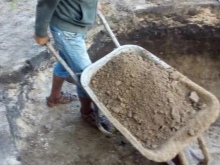
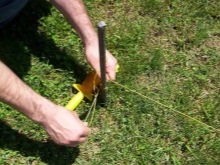

How to do it yourself?
A soft blind area around a building or structure does not require concreting; its laying can be carried out almost at any time throughout the year, but preferably at positive atmospheric temperatures. The installation scheme remains unchanged, regardless of the choice of materials. The technology of their laying has also been worked out by professionals for a long time. It is enough to follow the step-by-step instructions.
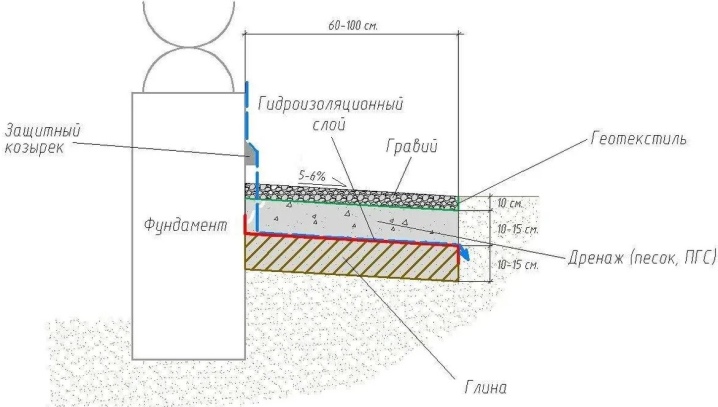
Preparation
At this stage, the preparation of the site is carried out, on which the soft blind area will be located. The area for earthworks is marked with pegs, a cord is pulled over them. Inside this contour, a trench is dug 30 to 40 cm deep, up to 80 cm wide (measured from the building wall).
On the bottom of the resulting ditch, a layer of clay of 100–150 mm is scattered (under a slope - for better outflow of water). The material is carefully compacted, slightly moistened with water. You need to wait until the clay is completely dry, otherwise, with further filling of the soft blind area, it will crack. This is the so-called hydraulic lock, well known to builders.
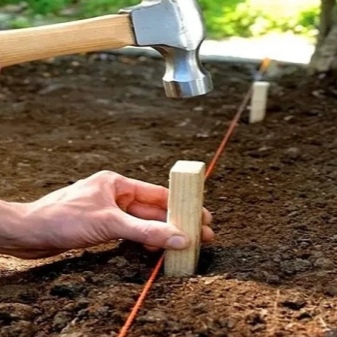
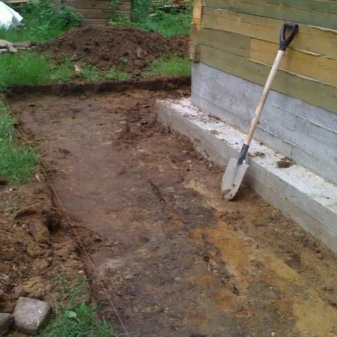
Diversion system
The meaning of creating a water drainage system in such a multilayer structure is to drain the collected moisture into the drain. In this case, the soil under it will not sink. For the installation of the drainage system, a specialized perforated pipe is used. Previously, these elements are wrapped in geotextiles. It will not allow clay, soil, debris to clog the holes in the drainage system.
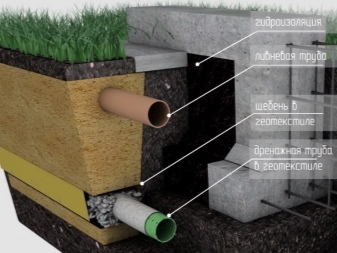

Laying layers
The multi-layer “cake” used in the construction of the soft blind area is laid in a specific sequence to ensure proper drainage and filtration of the effluent. Layers are bookmarked according to a certain scheme.
- Waterproofing material. It should cover the clay, as well as part of the trench wall to a height of about 10 cm. It is better to use modern membranes.
- Insulation. On top of it, 1 more waterproofing layer is laid. If the system does not need additional insulation, this step can be skipped.
- Crushed stone. The layer thickness in this case is higher, about 150 mm or more, depending on the total depth of the trench.
- Geotextile that separates the layers from each other.
- Sand. A 100 mm pillow, thoroughly moistened and compacted, is enough.
- Geotextile acting as a filtering layer. A system of drainage pipes is mounted on it, connected by tees.
- Sand and gravel mixture. This finishing layer is made up to 40 mm high, and sometimes more (up to the edge of the trench). A new layer of geotextile is placed on top of it, if decorative finishing is supposed to be done. You can leave a soft blind area and so. The backfill looks quite simple, while it can withstand significant pressure and mechanical stress.
- External decorative coating.
After all the layers are laid, the soft blind area is considered ready. It can be used for its intended purpose, there is no need to wait until the concrete solution hardens, as is the case with the capital - solid - analogue.

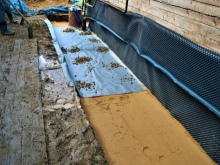
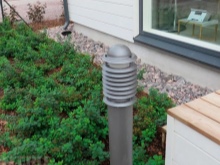
Warming and waterproofing
Thermal insulation is necessary in cases where there is a risk of soil freezing. In this case, an additional layer will help extend the life of the entire water drainage system. The insulated soft blind area is formed at the initial stage of ditch preparation. A waterproofing coating is unfolded over the clay. On it is a layer with insulation, its thickness is calculated individually, usually about 50 mm.
In this case, extruded polystyrene foam acts as an insulating layer. It does not rot and has good resistance to other external influences. You can also use expanded polyurethane or foam.
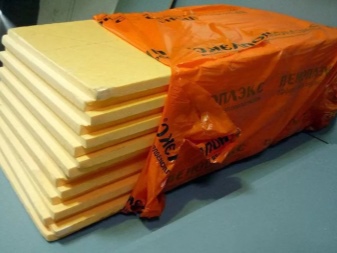
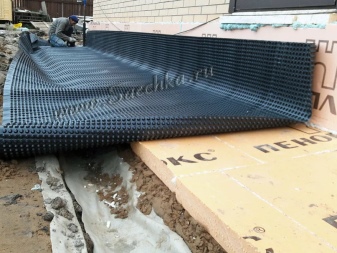
Finishing options
The finished soft blind area rarely remains without decorative trim. The simplest solution would be to floor an artificial or natural roll lawn on top of it. In this case, the design of the local area will correspond to the general aesthetics of the well-groomed area. When using a natural lawn, it is necessary to regularly scarify it, make sure that the roots do not grow over the backfill bed.
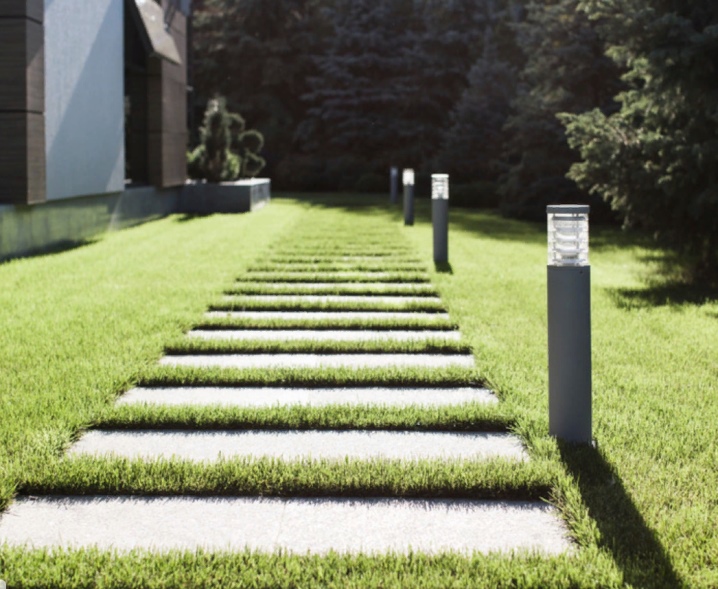
The backfill covering of the soft blind area, made of pebbles and colored granite chips, looks no less interesting. Such decoration can be a good addition to chalet, country, nautical buildings.
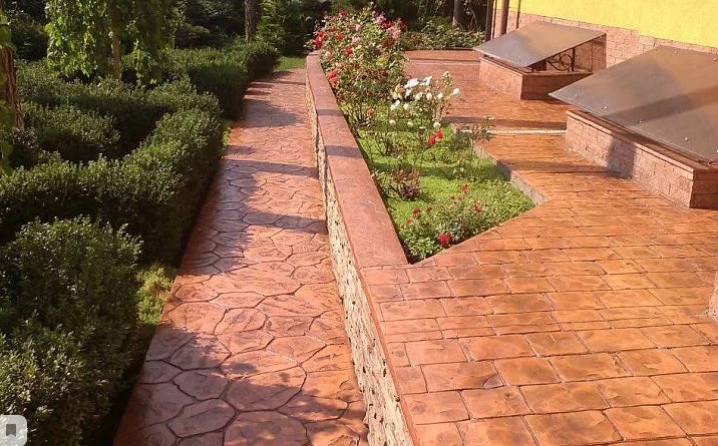
Paving slabs can also be a good addition to a soft blind area. In this case, it is laid on a layer of sand scattered over the geotextile. You can complement the decorative trim with borders. Variants in which the strict geometry of the tiles are combined with fantastically laid flagstone also look interesting.
In this case, you can beat the complex shape of a site or object along which a system is being built to remove excess moisture.
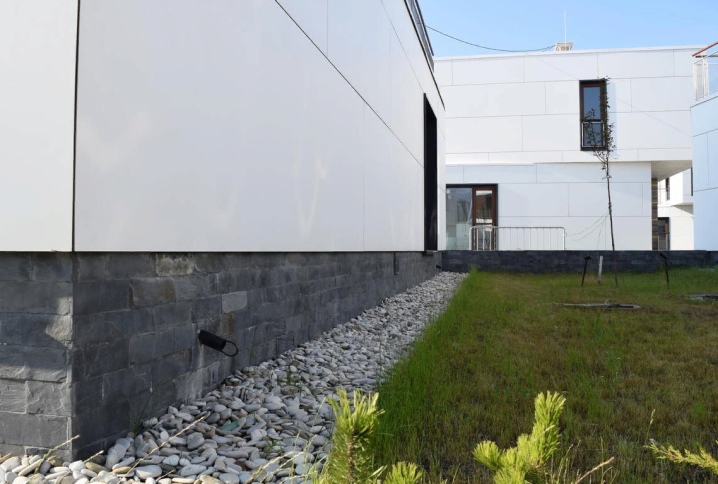
Possible mistakes
When deciding to equip a soft blind area around the building on a pile-grillage foundation, it is formed at the construction stage. It will not be possible to carry out the work later. The fact is that in this case, the blind area should go under the building structure by 30-50 cm. If this is not done, the rate of water drainage will be reduced.
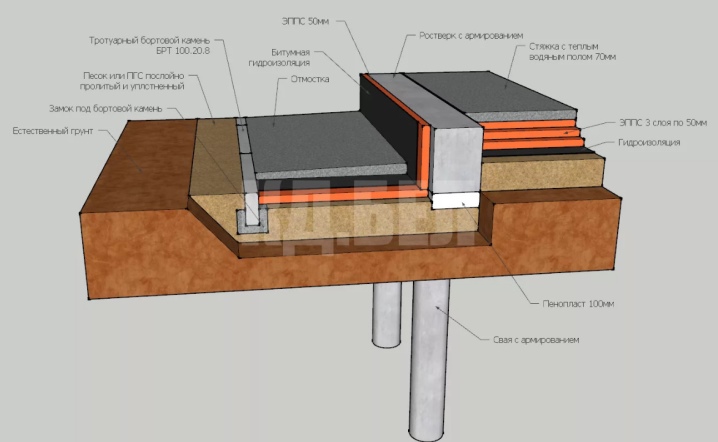
We list other common mistakes when arranging a soft blind area.
- Incorrect calculations. Often, when determining the depth of the trench, the thickness of the insulation layer is not taken into account. It is necessary to allocate an additional 50–100 mm for it.
- Conclusion of the drainage system into the ground. This is not recommended. With constant contact with moisture, the hydro-barrier is washed away and sags. This will cause the entire soft area to shift.
- Incorrect slope location. It should go from the building, not under it. An angle of 10 degrees is enough for each layer.
- Use of fine crushed stone. On clay soil, it can quickly silt up and stop performing its filtering functions.
- Wrong order of layers. Any violation will lead to the fact that the soft blind area simply will not perform its functions.
These errors are the most common. In addition, all materials used must be of high quality, safe. You should not take crushed limestone instead of gravel - it will quickly lose its properties. It is better to use washed or river sand. It is quite clean and has good filtering properties.

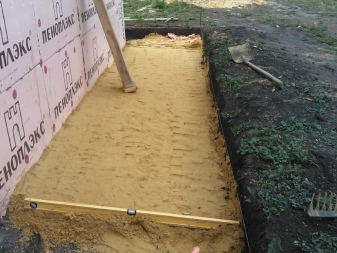
About what the blind area should be, see below.













The comment was sent successfully.